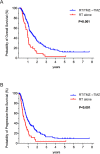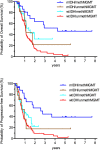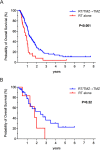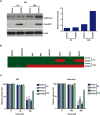IDH mutation and MGMT promoter methylation in glioblastoma: results of a prospective registry
- PMID: 26503470
- PMCID: PMC4747376
- DOI: 10.18632/oncotarget.5683
IDH mutation and MGMT promoter methylation in glioblastoma: results of a prospective registry
Abstract
Background: The relative contribution of isocitrate dehydrogenase mutations (mIDH) and O6-methylguanine-DNA methyltransferase promoter methylation (methMGMT) as biomarkers in glioblastoma remain poorly understood.
Methods: We investigated the association between methMGMT and mIDH with progression free survival and overall survival in a prospectively collected molecular registry of 274 glioblastoma patients.
Results: For glioblastoma patients who underwent Temozolomide and Radiation Therapy, OS and PFS was most favorable for those with tumors harboring both mIDH and methMGMT (median OS: 35.8 mo, median PFS: 27.5 mo); patients afflicted glioblastomas with either mIDH or methMGMT exhibited intermediate OS and PFS (mOS: 36 and 17.1 mo; mPFS: 12.2 mo and 9.9 mo, respectively); poorest OS and PFS was observed in wild type IDH1 (wtIDH1) glioblastomas that were MGMT promoter unmethylated (mOS: 15 mo, mPFS: 9.7 mo). For patients with wtIDH glioblastomas, TMZ+RT was associated with improved OS and PFS relative to patients treated with RT (OS: 15.4 mo v 9.6 mo, p < 0.001; PFS: 9.9 mo v 6.5 mo, p < 0.001). While TMZ+RT and RT treated mIDH patients exhibited improved overall survival relative to those with wtIDH, there were no differences between the TMZ+RT or RT group. These results suggest that mIDH1 conferred resistance to TMZ. Supporting this hypothesis, exogenous expression of mIDH1 in independent astrocytoma/glioblastoma lines resulted in a 3-10 fold increase in TMZ resistance after long-term passage.
Conclusions: Our study demonstrates IDH mutation and MGMT promoter methylation status independently associate with favorable outcome in TMZ+RT treated glioblastoma patients. However, these biomarkers differentially impact clinical TMZ response.
Keywords: IDH; MGMT; glioblastomas; radiation; temozolomide.
Conflict of interest statement
The authors declare no conflicts of interest..
Figures




References
-
- Chalmers TC, Smith H, Jr, Blackburn B, et al. A method for assessing the quality of a randomized control trial. Control Clin Trials. 1981;2:31–49. - PubMed
-
- Hannan EL. Randomized clinical trials and observational studies: guidelines for assessing respective strengths and limitations. JACC Cardiovasc Interv. 2008;1:211–7. - PubMed
-
- Bartek J, Jr, Ng K, Bartek J, Fischer W, Carter B, Chen CC. Key concepts in glioblastoma therapy. J Neurol Neurosurg Psychiatry. 2012;83:753–60. - PubMed
Publication types
MeSH terms
Substances
Grants and funding
LinkOut - more resources
Full Text Sources
Other Literature Sources
Research Materials
Miscellaneous

